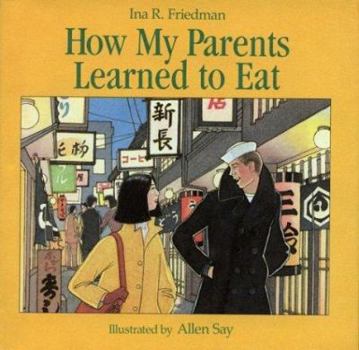How My Parents Learned to Eat
Select Format
Select Condition 
Book Overview
An American sailor courts a young Japanese woman and each tries, in secret, to learn the other's way of eating. This description may be from another edition of this product.
Format:Hardcover
Language:English
ISBN:0395353793
ISBN13:9780395353790
Release Date:January 1984
Publisher:Harcourt Brace and Company
Length:32 Pages
Weight:0.82 lbs.
Dimensions:0.4" x 8.6" x 8.3"
Age Range:4 to 7 years
Grade Range:Preschool to Grade 2
Customer Reviews
5 ratings
THE TABLE OF BROTHERHOOD OR THE FAMILY TABLE
Published by Thriftbooks.com User , 21 years ago
This story is narrated by a bright little girl who describes how her parents met and adapted to one another's cultures. A bright, beautiful child, the girl is blond like her American father and has beautiful Asian features she inherited from her Japanese mother. She tells the story of how they came to sit at the family table. An American sailor meets a woman in Japan and is instantly smitten. Their attraction is mutual; however each worries about being able to adapt to the other's culture. The sailor learns to eat with chopsticks and the woman in turn learns to eat with a knife, fork and spoon. She approaches her grandfather, a kind, scholarly man who teaches her the British way of handling western utensils. Still she worries because her fiance is American. They meet again; their transcultural love shows they really have more common grounds than differences. Each is moved by the other's willingness to learn the other's culture and the results are heartwarming indeed. Their daughter joins them and all readers at the Table of Brotherhood which once again proves that people really have more in common than they do differences. This is such a wonderful book. I love it! I think it belongs in all homes and classrooms because it is an excellent example of cultural harmony and pride.
Wise and muted, simple and understanding
Published by Thriftbooks.com User , 21 years ago
The author of this Reading Rainbow Selection is wise; she knows how eating styles and habits can separate people and be inhibiting. The narrator recalls how her parents met: a white American sailor and a Japanese woman from the port city of Yokohama. The girl tells the reader that some days, in her house, they eat with chopsticks, and on some days with knives and forks. In the clear, muted watercolors, the reader finds her eating with chopsticks with a rice cooker on the first page, and eating with a knife and fork with a toaster on the last. Somewhat like O. Henry's story, The gift of the Magi, the sailor is too embarrassed to eat with Aiko, since he cant use chopsticks. And Aiko is frightened to eat with John, for she has never used a fork. But the port call is ending in a few weeks, so both rush to learn the other's ways, and an eating date is finally arranged. Love conquers all.
A wonderful message with no preaching
Published by Thriftbooks.com User , 22 years ago
A bi-racial child tells the story of how her Japanese mother and American father met, fell in love, struggled to understand each other's ways, and finally married. It's a wonderful portrait of diversity, showing children that superficial differences in cultures don't really mean much and shouldn't get in the way of people appreciating each other. But just as important to me is the fact that this is one of the few children's books I know of that shows adults falling in love in a realistic way - no fairy tale, love at first sight kind of thing, but a picture of love growing as two people learn more about each other. Those two qualities - its appreciation of cultural diversity and its honest portrait of love - make it a little gem.
My daughter loves this book.
Published by Thriftbooks.com User , 23 years ago
The book is very obviously about the parents' relationship - but from their child's perspective. It teaches respect for other cultures by showing two people who care about one another enough to overlook their differences.The narrator (the daughter) is very matter-of-fact about her cultural mix - cheerfully noting that some days they eat with knives and forks and some days with chopsticks.My 6-year-old daughter loves it so much that she demanded to be taught to use chopsticks so we have an "Asian dinner night" once per week.
An excellent book for multicultural classrooms
Published by Thriftbooks.com User , 26 years ago
"How My Parents Learned To Eat" presents Japanese and American cultures in a story. The readers read about the cultural values through a little girl's first person narrative. From her telling, the readers will understand Japanese customs in its cultural context, such as bowing for greeting and drinking soup from the bowl. These concepts may be foreign or even funny to Americans who are unfamiliar Japanese culture. The author, however, successfully weave elements from both Ameriacn and Japanese cultures into the story. The respect for both Japanese and American cultures is also evident in the book. Not only did the mother (Japanese) want to learn the Western way of eating, but the father (American) is also willingly to learn the Japanese way of eating. So, in the end of the story, the little girl says again, "That's why at our house some days we eat with chopsticks and some days we eat with knives and forks" (p. 32).




